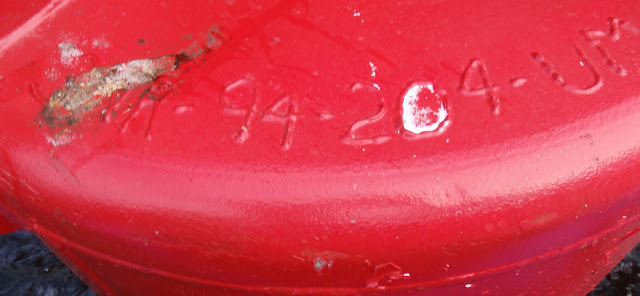Update: In 2010 the buoys arrived somewhere between Dec 1 and Dec 4.
Last year, on October 9th, we were out paddling on the Penobscot River when Coast Guard Coastal Buoy Tender 544 the Marcus Hanna came by.
We paddled after it and watched as it pulled a buoy from the river. The buoy disappeared from view onto the deck. Soon after our short attention span (think squirrels) passed and our still bodies began to chill, so we turned back and headed home. Then next day we paddled back to the buoy, and took a photo to see if we could see what had been done. New Buoy:
Once we got back and compared the photo with an older photo, the differences became obvious. Older Buoy:
I thought that in the winter they put a tougher buoy in the water, the better to withstand the destructive power of freezing cycles and massive chunks of ice propelled by spring runoff.
By April 22 the old buoys were back, I don’t know the exact date they appeared. The Marcus Hanna was deployed to the Gulf of Mexico to help with the BP oil spill in March 2010.
You may have noticed that buoys appear in many of our photos, buoy 7 between Sheep Porcupine and Rum Porcupine off Mount Desert Island, buoy 3 between Lubec and Eastport. One of my favorite buoy photos this year was buoy 1, between Sears Island and Isleboro.
It is a beautiful three tiered bell buoy, marking the outside edge of the shipping channel.
A week ago in anticipation of the changing of the buoys we paddled up once again, this time to get the serial number of the buoy.
We want to see if exactly the same buoy comes back in the spring. Our task was hampered by the current, and some sort of animal remains/droppings which needed to be scraped off the serial number.
All last week I was certain the tender would be back, and we’d get better pictures of the transition. But no luck. I began to doubt my original hypothesis. Maybe the swapping was just once every five years; what I thought of as winter buoys were just substitute buoys.
So I went where everyone goes for answers, Google. In the midst of several Coast Guard press releases about installing winter buoys, I found a handy Coast Guard Power Point presentation on buoys. Now I know so much more! Ocean buoys have an open grid on top and river buoys have a solid top and a below water fin to help them hold direction in the current.
The presentation goes on to explain the serial number. The first digit is the class; generally reflecting the buoy size. The second, a letter, says whether it is a can or a nun buoy. That’s also obvious from the color, can’s are green (like peas) and have odd numbers on them. Nuns have a nun like pointed cap, are red, and even numbered. Red nuns mark the right side of a channel, green cans mark the left side (sides arranged as you approach the harbor.) The old navigational rule “Right Red Returning” helps us remember where we’re more likely to get hit by a large boat. The third letter is an “R” if it is radar reflective. Then the next two digits show the year it was built. On the summer buoy the three digits after that means it was the 204th buoy built in 1994. “UM” is a code identifying the manufacturer.
I also found this attractive pamphlet about the prior buoy tending class, the 133 foot buoy tenders, which includes a lot of information on buoy history and a focused picture of the Marcus Hanna, a 175 foot buoy tender.
And I learned that Marcus Hanna is named for a Cape Elizabeth lighthouse tender who in 1831 risked his life to save two people from the schooner, Australia, which had caught on a ledge in a winter storm. He is the only lighthouse keeper to be awarded the Medal of Honor and the Gold Lifesaving Medal.
It’s a busy week ahead, I don’t know if I’ll catch the buoy tender. But I’ll be keeping watch.
There are at least two rivers kept open for shipping in Maine, the Kennebec and the Penobscot. And there are buoys in Belfast harbor, at the mouth of the Passy. As I travel about this fall and winter I’m going to be looking for other sightings of replacement buoys.
As a final note, I also found an article saying that the Coast Guard is looking to eliminate many buoys. With all the maintenance involved I can understand, but I would miss them.








Loved reading this. Thank you for blogging!
ReplyDelete